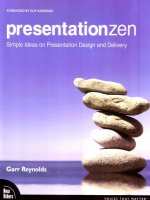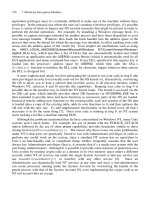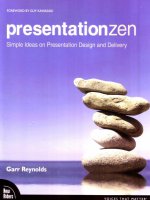presentation zen Simple ideas on presentation design and delivery phần 10 pot
Bạn đang xem bản rút gọn của tài liệu. Xem và tải ngay bản đầy đủ của tài liệu tại đây (2.98 MB, 18 trang )
Keep the Lights On
It is a common reaction all over the world: Just as the presenter is ready to begin,
someone shouts "could you get the lights, please!" And the room becomes
shrouded in darkness, save for the light reflecting off the screen. The presenter? She
must be there somewhere, I can hear her speaking (or is that the audience
breathing?).
If you want your presentation to be more effective, then don't touch that light
switch. Even when you are using slides, the more lights you can keep on, the better
off you will be. Remember, you're trying to connect, to tell a story, to sell an idea to
the board or other decision makers. It is very difficult to make a connection if the
audience can't see you. The audience is not there to witness the narration of slides;
they are there to
listen to you and become engaged with you and your topic. If the
audience can't see you, they will find it difficult to listen, and they are certainly more
likely to tune you out.
The audience must experience both your "verbal speech" and your "visual
speech." A relatively small part of your message is actually verbal. The rest of your
message is expressed visually and vocally. Influencing people verbally becomes far
more difficult when they can't see you.
Cliff Atkinson reminds us of the evidence that supports the claim that the more
the audience can both see and hear you, the better. "It turns out that when you
watch people speak, the visual cues help you to predict and understand the
auditory cues that follow soon after. These visual cues are actually not limited to
the lips, but include the entire human face," says Atkinson. According to the
authors of Why Business People Speak like Idiots (Free Press), " human beings
are hard-wired
to draw much more meaning from people than they are from the
information that people present." True, but they've got to see you.
Ten years ago, projectors were not all that bright, so turning the lights off made
more sense. Today,
even inexpensive business projectors are usually bright enough
for a smaller venue or teaching situation. There is no good reason for turning off all
the lights today in most situations. In many cases, you just have to compromise. The
slides may look better with all the lights off, but you'll disappear. With all the lights
on, the screen may wash out completely. In this case, you can dim just the lights in
front if possible. Look for a balance, but do not present in the dark.
208 Presentation Zen
In corporate meeting rooms across
Japan, common practice is to turn all or
most of the lights off for presentations. It
is also very common for the presenter to
sit on the side or back of the table
operating the PC while the audience
stares at the screen as the "presenter"
narrates the slides. This practice is so
common that it is considered "normal." It
may be normal, but it is not effective.
Audiences will better understand the
presenter's message when they can
both hear and see the presenter.
Chapter 9 Connecting with an Audience 209
Remote Simplicity: Use a Small Remote
to Advance Slides
I see a lot of presentations by very smart people, yet all too often the presenter
either uses a remote poorly (as if it is the first time he's seen such a device) or does
not use a remote at all. Even today, too many presenters stay next to the computer
on a table or lectern or walk back to the computer to change slides every few
minutes.
Remote control devices for computers are relatively cheap and an absolute must.
No excuses, you've got to have one. If you are not currently using a remote to
advance slides, adding a remote to your delivery style will make a huge difference.
The remote allows you to get out front closer to the people, to move to different
parts of the stage or room, and to make those connections.
When we stay glued to the laptop and look down to advance every slide, our
presentations become more like slide shows with narration, the kind our uncle used
to bore us with when he whipped out his 35mm slide projector with highlights of his
latest fishing trip. Yawn.
Remember, you want the technology behind your presentation to be as invisible as
possible to the audience. But when you have your hand on the computer and your
eyes are moving back and forth from the computer screen, to the keyboard, to the
audience (or projection screen), this becomes more like the typical PowerPoint
presentation that people complain about.
Small and basic is all you need. I prefer small remotes with only the most basic
features. You can buy remotes that you can mouse around with onscreen and are
equipped with myriad other features, but they are large and call attention to
themselves. All I really need is the ability to advance, go back, and turn the screen
black. Very simple.
210 Presentation Zen
In Sum
You need solid content and logical structure, but you also have to make a
connection with the audience. You must appeal to both the logical and the
emotional.
If your content is worth talking about, then bring energy and passion to your
delivery. Every situ
ation is different, but there is never an excuse for being dull.
Don't hold back. If you have a passion for your topic, then let people know it.
Remember hara hachi bu. It is better to leave your audience satisfied yet
yearning for a bit
more of you than it is to leave your audience stuffed and
feeling that they have had more than enough.
Keep the lights on; the audience must always be able to see you.
Remove any barriers between you and the audience. Avoid podiums (lecterns),
if possible. And use
a wireless mic and remote control for advancing slides so
that you can move around freely and naturally.
Chapter 9 Connecting with an Audience 211
- Buddha
The Journey Begins
Many people look for the short road and the quick fix to achieve presentation
excellence. But it doesn't exist: there are no panaceas or off-the-shelf fixes.
Learning to become an exceptional presenter in today's world is a journey. In this
journey, there are many paths to presenting in a more "enlightened" way, a way
that is appropriate for the world in which we live. The first step down the road to
becoming a great presenter is simply seeing—really seeing—that that which
passes for normal and ordinary and good enough is off-kilter with how we learn,
understand, remember, and engage.
No matter what your starting point is today, you can become much better. In
fact, you can become extraordinary. I know this is true because I have seen it many
times before. I have worked with professionals—young and old—who believed that
they were not particularly creative, charismatic, or dynamic, and yet with a little
help they were able to transform themselves into extremely creative, highly
articulate, engaging presenters once they realized that that person that remarkable
presenter was in them already. Once they opened their eyes and made the
commitment to learn and leave the past behind, it was just a matter of time before
great progress was visible. Interestingly, as their confidence grew and they became
more effective presenters, their newly found confidence and perspective had a
remarkable impact on other aspects of their personal and professional lives.
Chapter 10 The Journey Begins 217
How to Improve
There are many things you can do to become a better presenter (with or without
the use of multimedia) and a better, more effective communicator in general. Here
are just a few things to keep in mind.
Read and Study
Through books, DVDs, and myriad online resources, you can teach yourself much
of what is needed to be an exceptional presenter. I list over 75 books, DVDs, and
Web sites on the Presentation Zen Web site (presentationzen.com
) which are
related to presentation design and delivery. Most of the items recommend are not
necessarily about presentation skills or slideware at all. However, these are the
resources that are often the most helpful. For example, you can learn a lot about
storytelling and the use of imagery by studying the masters of documentary film
and cinema. Even books on writing screen plays will teach you lessons you can
apply to the world of presentations. You just never know what you'll learn through
self-study, especially when you look in unusual places.
Just Do It
Reading and studying are important and necessary, but to really get better at
presentations—including the design of visuals you have to actually do it, and do it
often. So look for
opportunities to present. If there is a local Toastmasters
(www.toastmast
ers.org) chapter in your area, consider getting involved. You'll not
only get many opportunities to speak and present with Toastmasters, but you'll also
expand your network and make new friends, all of whom have an interest
in mastering public speaking. Volunteer to present for your
school, business, or civic group, and look for
opportunities to "give it away."
218 Presentation Zen
Finding inspiration in jazz
…
Exercise Your “Right Brain”
It is important for working professionals—no matter
what their field is—to stay in touch with their
"creative soul" and to nurture it. What a waste it
would be to ignore one of your passions or talents.
Frankly, you just never know where inspiration will
come from. Inspiration, clarity, or a new perspective
may materialize unforced as you climb that mountain, paint that portrait,
photograph that sunset, write that novel , or find that "pocket" while playing with
fellow musicians in a downtown nightclub.
I no longer play music fulltime, but I still perform from time to time with local jazz
musicians or blues bands in Japan. It's so good for the creative soul to play live and
connect with other musicians and an audience. Blues especially is about connecting
and telling a story through the words and music. It's about feelings. Playin g the
blues well is similar to making great presentations: it's not about technique. Once
you begin to focus on technique and tricks and flash and making an impression, all
is lost. If I never played music I would miss all the lessons.
Get Out
Nothing great will ever happen to you if you stay in your comfort zone. So as
much as you can, get out of your office or school or house and make
connections and look to exercise the right side of your brain. Out there" is
where the learning occurs. Challenge yourself and develop your creativity;
exercise your creative brain. Take a drama class. Take an
art class. Go to a movie. Go to a concert. Go to a
play or a musical. If you're a musician, join an
orchestra or jam with friends or form a band. Or just
go for an inspirational walk alone.
Chapter 10 The Journey Begins 219
Or visiting a temple in Kyoto
Lessons Are All Around You
We can find inspiration and lessons in
unexpected places. For example, over the
years I've learned a lot about graphic
design—what's effective and what's not—
during the morning commute on the trains.
Trains here in Japan are clean,
comfortable, and on time. The trains are
also full of print advertising hanging and
affixed to every conceivable space. I enjoy
scanning the print ads while I commute as this gives me a chance to keep abreast
of new products and events, and also to study graphic design trends and observe
the way graphics and print are used in the media. You can learn a lot about
fundamental design principles and develop a critical eye through careful
examination of graphic design found in posters, banners, street signs, store
fronts, and so on. We usually ignore or take for granted so much of the design in
an urban setting, but just walking down the street you'll find that the examples
from which to learn are all around you. The lessons are everywhere. It's just a
matter of seeing.
It's Within You Already
The key is in knowing that it is within you already. Do not rely on Microsoft or Apple
or anyone else to dictate your choices. Most of all, do not let mere habit—and the
habits of others—dictate your decisions on how you prepare and design and
ultimately deliver your presentations. The secret is in increased awareness and
being able to see the world and all the lessons around you. We cannot truly move
forward and learn the new if we cling to the old. The essential key to improvement
is simply having an open mind, an open heart, and a willingness to learn and even
to make mistakes in the process. There are many ways to improve and transform
yourself. In this chapter, I have listed just a few that I hope will be of help to you.
220 Presentation Zen
Conclusion
So, what's the conclusion? The conclusion is there is no conclusion, there is only the
next step. And that next step is completely up to you. In fact, far from being the
conclusion, for many this is just the beginning. In this book I have tried to give you a
few simple things to think about as you work toward improving your presentation
preparation, design, and delivery skills. This book focused on presenting while using
slideware such as PowerPoint or Keynote, yet the use of multimedia technology is
not appropriate for every case. You decide. But if you do use slideware in your next
talk, aim to design and deliver your presentation while allowing the principles of
restraint, simplicity, and naturalness to be your gentle guide. Enjoy the journey.
Chapter 10 The Journey Begins 221
A journey of a thousand miles
Begins with a single step
- Lao Tzu









